
On Tuesday, General Motors (GM) announced a positive change in its full-year profit forecast, largely due to its strategic plans to reduce investments in new products and implement cost-cutting measures. The automaker aims to save an additional $1 billion in operating costs by the end of the following year.
GM’s second-quarter net income demonstrated significant growth, rising by nearly 52% to reach $2.6 billion, thanks to a 25% increase in revenue compared to the same period last year, during which semiconductor shortages impacted production.
Also, don’t forget that you can get discounted new car pricing with a free quote through qualified local dealer partners.
As a result of these developments, GM’s shares experienced a modest increase of 0.4%, reaching $39.45 during premarket trade.
With the improved financial performance, GM now anticipates full-year net income to be in the range of $9.3 billion to $10.7 billion, up from its previous forecast of $8.4 billion to $9.9 billion. On a per-share basis, GM’s net income projection for the year has been adjusted to a range of $7.15 to $8.15, an increase from the earlier forecast of $6.35 to $7.35.
Notably, this updated outlook does not include any potential costs associated with a strike by the United Auto Workers union, provided they fail to reach a new contract agreement with GM by the September 14 deadline.
Chief Financial Officer Paul Jacobson credited this more optimistic outlook to six months of stronger demand and better pricing than initially expected. He highlighted the automaker’s commitment to profitability and not compromising margins for increased volume. This strategy has proven successful in recent results, leading the company to focus on building a stronger foundation beyond 2023.
To support its profitability goals, GM has decided to scale back its capital investments, aiming to spend $11 billion to $12 billion this year, compared to the previous plan of $11 billion to $13 billion. However, specific projects affected by this reduction were not disclosed.
The automaker also aims to further cut operating costs, announcing an expanded initiative to save $2 billion by the end of 2024. This now includes targeting an additional $1 billion in savings from overhead, marketing, and other expenses.
In contrast to Tesla’s CEO, Elon Musk, who adopted a strategy of reducing prices to drive demand, GM opted to increase the average transaction prices for its vehicles in North America by approximately $1,600, bringing them to about $52,000 in the latest quarter.
GM’s decision to cut new product investments and operating costs comes amid mounting pressure on the company’s profit margins. While GM’s pretax profit improved to 7.2% of revenue in the second quarter compared to the previous year, the pretax margins for the first half of the year dipped to 8.3% of revenue, down from 8.9% in the same period last year.
GM’s second-quarter results included a $792 million charge related to new commercial agreements with South Korean battery maker LG Energy Solution. The automaker agreed to take on more costs associated with the recall of Chevrolet Bolt electric vehicles to replace LGES batteries that were at risk of catching fire. However, GM expects these agreements to lead to lower battery costs in the future without providing further details.
In China, GM’s second-largest market, the company reported a profit of $78 million, reversing a loss from the previous year. Nevertheless, GM’s earnings in China remain lower than before, as local Chinese electric vehicle brands and Tesla continue to gain market share. The economic recovery in China has slowed down, leading to heightened price competition, but GM managed to increase its combustion vehicle sales by 38%, despite overall market share losses for petroleum-fueled vehicles.
Source: Reuters